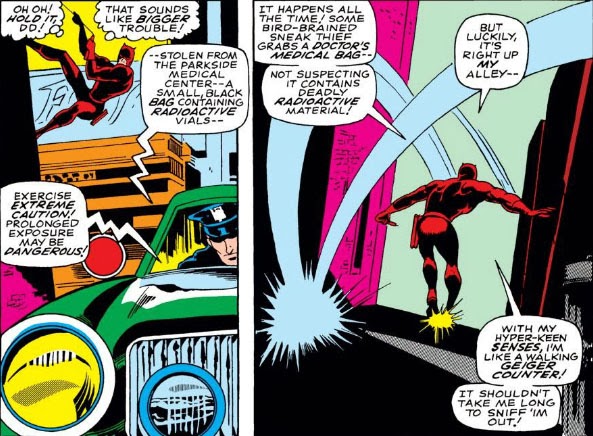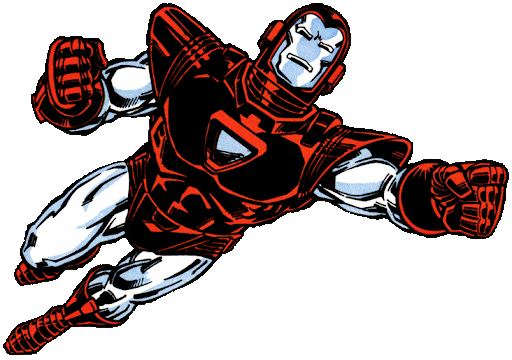When Leonard Samson had the incredible Hulk on his psychiatric "couch" for
analysis, he was only able to learn fragments of Bruce Banner's life as seen through the eyes of his brutish alter-ego--fragments which provided clues to the violence and isolation which were present in Banner's growth to adulthood. At the time, Samson was only able to conclude that Banner and the Hulk were "not just two sides of one mind... they are actually two separate beings"--a rather startling statement to make, since it would seem to suggest that there is no "cure"
per se for the Hulk as he appears to be a long-suppressed side to Banner that's been given freedom by exposure to gamma rays. In other words, there's no putting the genie back in the bottle--which, in Banner's case, has certainly been
tried before.
In a later 1985 story, writer Bill Mantlo probes much deeper into Banner's past, and builds a profile of him which seems to sustain Samson's preliminary diagnosis but also provides much more context for us. And we discover that a gamma bomb explosion has taken the 1886 story,
Strange Case of Dr Jekyll and Mr Hyde, to its ultimate degree. But instead of "Hyde" we get "Hulk"; and instead of evil and a lack of morality, we get a release valve of Banner's pent-up anger and childhood dreams. And while we come to understand the Hulk bears no real responsibility for his association with the word, this story is still appropriately titled:
Mantlo and artist Mike Mignola take us through several stages of Banner's life--as much as twenty-three pages will allow, but still a wealth of material on a man who, in over 300 issues, we're only just now learning of in any measure of depth. And thanks to the story's beginning, it becomes almost immediately clear who is responsible for setting the tone of Bruce Banner's unfortunate adolescence:
![]()
Bruce's father, Brian Banner, is a crucial part of Mantlo's interpretation of the Hulk--not just because of the obvious role he plays vis-à-vis his contempt and mistreatment of his son, but also because of Brian's unwavering belief that, because of his work in atomic research, his son will be born a mutant. It's an important concern for Mantlo to deal with, as "mutant" would be too convenient a label to pin on the Hulk and thus would have this story differ very little from other such stories (e.g. the McCoys, the Franks, et al.) where dangerous atomic exposure was involved. What eventually happens to Bruce Banner will top them all, in that regard; yet Mantlo will provide a different take on that fateful moment, while still keeping Brian's mutant fears a relevant part of the story without necessarily lending credence to them.
With Bruce's infant and toddler years, it's clear that Brian is in no danger of winning any Father Of The Year award. In addition to keeping his emotional distance from a son whom he fears may yet become a freak of nature despite the hospital's evidence to the contrary, he also resents Bruce now taking the lion's share of his wife Rebecca's time and affection:
To compensate, Brian often devises excuses for Rebecca to accompany him elsewhere; and, to make matters worse for Bruce, Brian has hired a stern and unsympathetic nurse to look after him. But Bruce has also found ways to compensate, by unfortunately drawing more deeply into himself:
By the time Bruce is four years old, Rebecca is still a positive presence in Bruce's young life--but during her absences, he's learned to interact with his beloved doll, "Guardian," in order to express his thoughts. So it's no surprise that the doll accompanies him just about everywhere--including a stealthy trip downstairs on Christmas Eve which practically any inquisitive child would want to make:
Mignola is a fine artist for this type of story, and the characterizations Mantlo provides can be seen so vividly in Mignola's depictions of the Banners. Brian almost always appears cold and distant, his temper on a hair trigger; Rebecca obvously holds much love for Bruce, but seems unable to either move her husband to show affection to him or break away from Brian's hold on her in even the smallest degree; while Bruce is seen in constant coping mode, helpless to affect his circumstances, and somehow knowing that his lot won't improve.
You've also probably noticed the ghostly outline of the Hulk hovering near Bruce in just about every panel, which could be interpreted as a prelude of what's to come--the beast within Bruce, biding his time until his inevitable release. Yet to me, it seems more of an indication of the kind of cloud Bruce is constantly living and growing up under--a reflection of the different forms of neglect and abuse heaped upon him, in one form or another, which the Hulk will later subconsciously register. The Hulk and Bruce at this point in time seem
very much the same being; but when the time comes when they aren't, and the Hulk's consciousness explodes and comes into its own, these scenes will have given us a better understanding of why.
A crucial point for Bruce's perceptions of home and family occurs during this very Christmas Eve, as Bruce begins to demonstrate his budding intelligence and drive, with no one around to inhibit him:
But it wouldn't be Christmas in the Banner household without an episode that both shatters what could be a happy memory for Bruce as well as reinforces the image of his father as an uncaring ogre. Thanks to Mignola, the dread that Bruce feels at his father's discovery of his efforts is an almost tangible thing for the reader as well:
(A slight oversight in that last word balloon--Brian no doubt meant his vicious wish to be directed at Bruce, not himself.)
Unfortunately, what would otherwise be a source of pride for another parent is instead a red flag for Brian, whose worst fears for his son seem to have been confirmed. And it's not just Bruce he lashes out at:
It would be the last we'd see of Rebecca Banner. Years later, when Bruce is attending a school for gifted science students, we would discover that he's now in the custody of his aunt, and that much has happened to his family in the years between:
The point about Bruce internalizing his rage is of course, in hindsight, a telling concern--particularly in instances where students who fall victim to pranks would normally give as good as they get. But in Bruce's case, these instances only serve to cork up that rage and add to it:
Conflict even follows Bruce to his mother's gravesite, where he visits on the anniversary of her death and encounters the last person he thought he'd ever lay eyes on. A person who hasn't left behind old enmities, and whose resentment has only grown with time:
The scene's purpose appears to be two-fold for Mantlo--giving us further details on what happened with his parents as well as showing that Brian has never let go of his hostile and bitter feelings toward Bruce, but also to put to bed once and for all any notion that Bruce is a mutant. Again, given what we know is coming, it's important at this point in the story for Mantlo to make that clear in no uncertain terms--assuming the story of Bruce's life up to now hasn't already done so.
For those of you who followed the "crossroads" stories--that dimensional "intersection" where the Hulk was exiled when the Bruce Banner persona was seemingly obliterated, leaving the Hulk a creature of pure rage--by now you've noticed the symbols in Bruce's childhood which spawned the triad of beings who were informal companions to the Hulk during that time. "Guardian," his favorite doll and protector; "Glow," which in the beginning hung above his crib and gave him delight; and "Goblin," representing those who were cruel and mocking toward him, such as his nurse and certainly his father:
We haven't seen the last of these symbols, even with Bruce grown into adulthood--and obviously they're playing an important role regarding the Hulk's state of mind while trapped at the "crossroads."
As we know, Bruce Banner goes on to become a renowned physicist, who eventually pursues studies in gamma radiation and, subsequently, the design of the gamma bomb for the government. And so "Desert Base" is our last stop, where he meets two more people whose personalities must seem familiar to him on a subconscious level:
And then, the moment comes, when a creature of conflicting emotions is born, but whose rage is almost always the end result of his transformation:
All of this, the Hulk has come to remember with the help of his "triad"--subconscious symbols of his past that, collectively, have allowed him to heal and bring his past into perspective. Yet the process has also done something else, something more important--it's allowed Banner to do the same, and for the first time to come to terms with the fact that "the Hulk" has been in the process of forming since his infancy, with gamma rays allowing that part of his id to take shape. And the realization allows Banner to recover from his own self-imposed exile within the deepest recesses of the Hulk's mind:
![]()
![]()
![]()
It's something of a landmark issue, which ends Mantlo's run on the book and hands off the baton to scripter/artist John Byrne who would determine what Banner's next steps would be. You would think this kind of revelation would open all sorts of doors to where Banner might want to go from here. When we touch on this story again, we'll see the interesting way that Byrne built on the foundation which Mantlo left with him.


































































































































































































































































